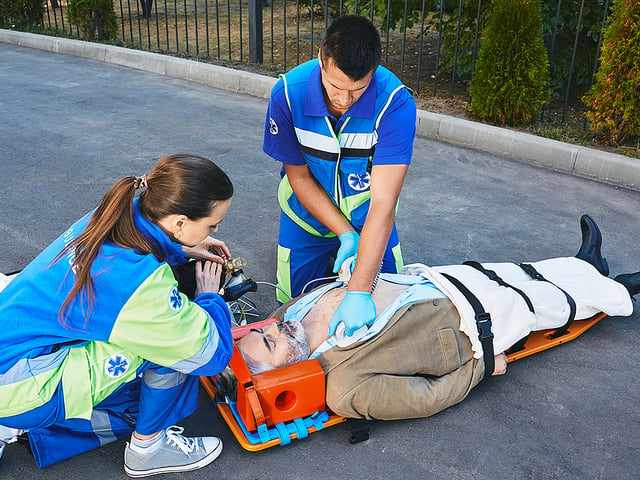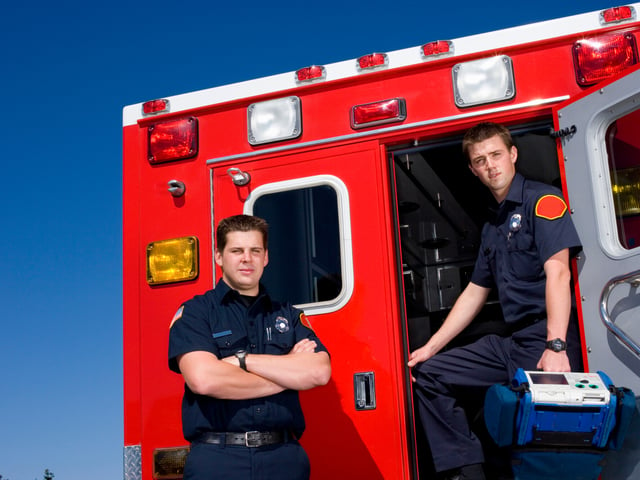
How Many Questions are on the NREMT?
The National Registry of Emergency Medical Technicians (NREMT) exam is a crucial test for individuals looking to become certified Emergency Medical Technicians (EMTs) in the United States. One of the first questions aspiring EMTs often ask is, “How many questions are on the NREMT?” This blog will break down everything you need to know about the structure of the exam and the number of questions to expect.
NREMT Exams
The National Registry of Emergency Medical Technicians (NREMT) serves as the certifying body for Emergency Medical Technicians (EMTs) across the United States. Often, when people hear “NREMT,” they immediately think of the EMT exam, but in reality, this organization oversees a spectrum of graded examinations, including the EMR, EMT, Advanced EMT (AEMT), and Paramedic exams. Each successive level represents a deeper and more specialized knowledge base in emergency medical care. Before reaching the EMT level, individuals can pursue certification as an Emergency Medical Responder (EMR), which covers initial on-scene interventions before advanced care arrives. The EMT exam covers basic emergency medical care, the AEMT delves into advanced procedures, and the Paramedic exam represents the pinnacle, encompassing the most advanced pre-hospital medical care techniques and knowledge.
NREMT Questions and Content for Emergency Medical Responders (EMRs)
Starting at the foundation of emergency medical care, the EMR certification focuses on the immediate lifesaving interventions that can be made in the crucial moments before more advanced EMS teams arrive on the scene. EMRs often act as the first on-scene responders, especially in areas where more advanced EMS personnel may be minutes or even hours away.
EMR candidates can anticipate between 90 to 110 questions during their exam. 30 are pilot questions and won’t count toward the final score.
EMR Exam Content Breakdown
Airway, Respiration & Ventilation (18%–22%): This section, making up roughly one-fifth of the exam, predominantly covers adult interventions (85%) related to airway management and breathing processes, but also includes pediatric considerations (15%).
Cardiology & Resuscitation (20%–24%): Forming around a quarter of the exam, this section provides insight into cardiac conditions and resuscitation methods for both adults (85%) and pediatric patients (15%), emphasizing the distinct challenges and techniques for each age group.
Trauma (15%–19%): Accounting for roughly 17% of the exam, this content area focuses on the recognition and management of traumatic injuries. While the majority of the material caters to adult trauma (85%), it also sheds light on pediatric trauma scenarios (15%).
Medical; Obstetrics & Gynecology (27%–31%): As the most substantial portion of the exam, this section provides a deep dive into general medical conditions and those related to reproductive health, with a primary focus on adults (85%) but also integrating essential pediatric knowledge (15%).
EMS Operations (11%–15%): Making up approximately 13% of the exam, this section delves into the operational facets of emergency medical services. While it generally addresses both adult and pediatric operational considerations, the provided breakdown suggests the content largely reflects adult scenarios.
NREMT Questions and Content EMTs
At the EMT level, candidates delve into the foundational aspects of emergency medical care. This certification is for those at the forefront of pre-hospital emergency situations, providing immediate medical care to patients.
Candidates can expect anywhere from 70 to 120 questions on their test, 10 of which are pilot questions and won’t be included in the final score.
EMT Exam Content Breakdown
Airway, Respiration, and Ventilation (18-22%): This section covers topics related to assessing and managing the airway, administering oxygen, and assisting with ventilation.
Cardiology and Resuscitation (20-24%): This section focuses on cardiac emergencies, including the recognition and treatment of heart attacks, arrhythmias, and cardiopulmonary resuscitation (CPR).
Trauma (14-18%): Trauma assessment and management, including bleeding control, fracture management, and spinal immobilization, are covered here.
Medical Obstetrics and Gynecology (27-31%): The Medical Obstetrics and Gynecology section of the NREMT exam covers topics related to pregnancy, childbirth, and gynecological emergencies, with a focus on assessing and managing medical conditions and complications in these areas.
EMS Operations (10-14%): EMS system operations, including scene safety, patient assessment, and the roles and responsibilities of EMTs, are covered here.
NREMT Questions and Content for Advanced EMTs (AEMTs)
Building upon the foundational EMT knowledge, the AEMT certification is for those who can provide both basic and limited advanced emergency medical care and transportation.
AEMT candidates will face 135 questions, 35 of which will not count towards the score.
AEMT Exam Content Breakdown
Airway, Respiration & Ventilation: This section covers the anatomy, management, and interventions related to the airway and the processes of breathing and ventilating patients.
Cardiology & Resuscitation (21%–25%): This segment delves into the heart’s function, pathologies, and lifesaving resuscitation techniques for cardiac emergencies.
Trauma (14%–18%): Here, the focus is on recognizing and managing traumatic injuries, encompassing everything from fractures to traumatic shock.
Medical; Obstetrics & Gynecology (26%–30%): This section encompasses a wide range of medical conditions, including those specific to women’s reproductive health and pregnancy-related emergencies.
EMS Operations (11%–15%): A deep dive into the operational aspects of emergency medical services, such as scene safety, communication, and transport considerations.
NREMT Questions and Content for Paramedics
The Paramedic certification represents the highest level of EMS certification. Those at this level have a broad scope of practice, including advanced medical procedures.
For the Paramedic level, candidates will be assessed with a range of 80 to 150 questions, 20 of which are unscored.
Paramedic Exam Content Breakdown
Airway, Respiration & Ventilation (18%–22%): This content area, accounting for approximately a fifth of the exam, covers adult and pediatric interventions related to airway management, breathing processes, and ventilation techniques.
Cardiology & Resuscitation (20%–24%): Making up about a quarter of the exam, this section delves into both adult and pediatric cardiac conditions, highlighting heart functions, related pathologies, and crucial resuscitation methods for heart-related emergencies.
Trauma (14%–18%): Focused on recognizing and managing various traumatic injuries in both adults and children, this section comprises about 15% of the exam, addressing topics from fractures to traumatic shocks.
Medical; Obstetrics & Gynecology (27%–31%): The most significant portion of the exam, this content area addresses a broad spectrum of general medical conditions and those specifically related to women’s reproductive health and pregnancy, serving both adult and pediatric patients.
EMS Operations (10%–14%): Approximately 12% of the exam is dedicated to the operational aspects of emergency medical services, emphasizing topics such as scene safety, communication protocols, and transport considerations for both adult and pediatric patients.

Overview of the NREMT Exam
The format and adaptive nature of the NREMT exam set it apart from many other standardized tests. Let’s delve deeper into what the computer adaptive test (CAT) design means for candidates and the purpose it serves.
What is Computer Adaptive Testing (CAT)?
Computer Adaptive Testing (CAT) is a cutting-edge testing methodology that tailors the test to the ability of the test-taker. Rather than presenting a fixed set of questions, a CAT adjusts in real-time based on the test-taker’s performance. Here’s how it works:
-
Starting Point: Every test-taker begins with a question of moderate difficulty.
-
Adaptive Questioning: If you answer a question correctly, the subsequent question might be slightly more challenging. Conversely, if you answer incorrectly, the next question might be a tad easier.
-
Continuous Evaluation: This adaptive process continues, allowing the system to pinpoint your level of competency with greater precision than a traditional test.
Why Use CAT for the NREMT Exam?
There are several advantages to using CAT for the NREMT exam:
-
Efficiency: CAT can determine a test-taker’s competency level with fewer questions than a fixed-format test, reducing the time and mental fatigue associated with longer exams.
-
Fairness: Since the test adapts to the individual, it provides a more accurate representation of a test-taker’s abilities.
-
Security: The dynamic nature of CAT means each test-taker has a unique set of questions, reducing the risk of cheating or question sharing.
The Aim of the NREMT Exam
Beyond its format, it’s essential to understand the ultimate goal of the NREMT exam. The test isn’t designed merely to challenge candidates but to ensure that each certified individual possesses the foundational knowledge and skills necessary to provide safe and effective care in emergency situations. The adaptive nature ensures that candidates are assessed on a broad spectrum of topics, ranging from basic first aid procedures to more complex medical scenarios.
Studying for the NREMT
Successfully tackling the NREMT examinations requires a comprehensive and strategic approach to studying. Given the breadth and depth of content covered, candidates must equip themselves with a suite of resources to optimize their preparation. Here are some essential study aids and tips to ensure you’re adequately prepared for exam day.
1. Practice Tests
Our practice tests are designed to emulate the real NREMT experience. They not only cover the requisite topics but also provide insights into the style and format of questions you can expect.
Benefits:
-
Familiarize yourself with the exam format.
-
Gauge your strengths and areas needing improvement.
-
Receive feedback and explanations for every answer, aiding in understanding and retention.
2. Study Guides
Our in-depth study guides are curated by experienced educators in the emergency medical field. These guides break down every topic you’ll encounter in the exam, presenting information in an easy-to-digest format.
Benefits:
-
Systematic coverage of all exam subjects.
-
Tips and strategies for answering different types of questions.
-
Real-world examples and scenarios to enhance comprehension.
3. Flashcards
Flashcards remain one of the most effective study tools, especially for memory retention. Our EMT flashcards cover key concepts, terminologies, and procedures essential for the NREMT exams.
Benefits:
-
Ideal for quick revision sessions.
-
Facilitates active recall, enhancing memory retention.
-
Portable and convenient for on-the-go studying.
Final Tips for NREMT Success
Consistency is Key: Establish a regular study routine. Allocate specific times each day for studying and stick to the schedule.
Mix and Match: Use a combination of practice tests, study guides, and flashcards to ensure a holistic preparation.
Stay Updated: The world of emergency medicine is continually evolving. Regularly check our resources for updated information and new practice questions.
Self-care: Ensure you’re getting enough sleep, eating healthily, and taking breaks during your study sessions.
Remember, while studying is vital, believing in yourself and your capabilities is equally crucial. With the right resources and a solid strategy, you’re well on your way to NREMT success!
Keep Reading

Emergency Medical Technician Test Blog
How Hard is the EMT Test?
EMTs (Emergency Medical Technicians) are required to have strong medica…

Emergency Medical Technician Test Blog
What Is a Passing Score on the NREMT Exam?
The job outlook for EMTs and paramedics is strong. The Bureau of Labor …

Emergency Medical Technician Test Blog
How to Pass the NREMT on the First Try
There are many great reasons to become an Emergency Medical Technician …